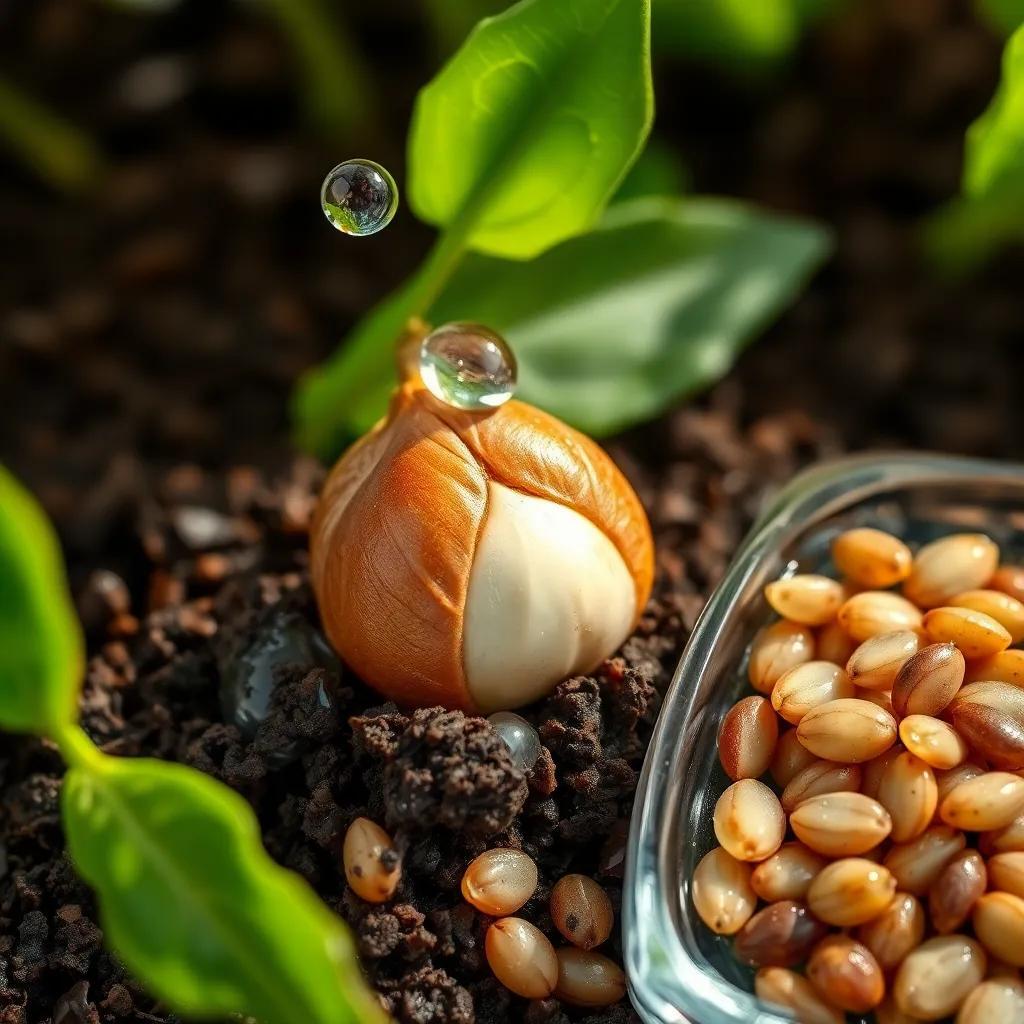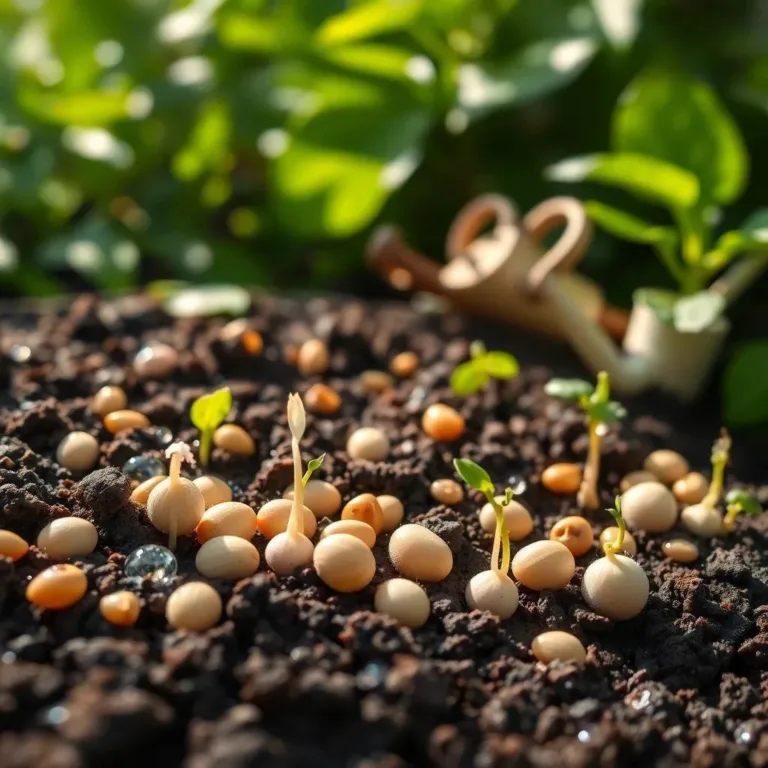Have you ever wondered how a tiny seed transforms into a magnificent plant? It’s like witnessing a magical transformation! In this article, I’ll take you on a journey through the amazing world of seed germination, exploring the keys to helping those little seeds grow healthy and strong. Get ready for some fun facts and tips that will make your gardening game stronger than ever!
Understanding Seed Structure and Function
Let’s take a closer look at seeds! They’re like nature’s little treasure chests, packed with everything a plant needs to get started. A seed is not just a simple grain; it’s a mini miracle with several important parts. When I think about seeds, I can’t help but marvel at how much potential they hold!
Here are the main parts of a seed:
- Seed Coat: This outer layer protects the seed. It keeps out pests and prevents damage from the environment. Just like my favorite snack bag, it keeps everything inside safe until it’s time to enjoy!
- Embryo: This is the tiny plant waiting to grow. It’s composed of the radicle (the future root) and the plumule (the future shoots and leaves). You could think of it as the star of the show, ready to break free and reach for the sun!
- Endosperm: This is the food source for the growing plant. It provides essential nutrients like carbohydrates, proteins, and fats. It’s like a hearty meal that powers the plant on its journey!
- Cotyledons: These are the first leaves that emerge from the seed. They often store food for the embryo until the true leaves develop. Think of them as the starter pack for the plant’s leafy adventures!
Understanding the structure of a seed helps us appreciate its role in the plant growth journey. Each part works together to give the plant the perfect start!
The Role of Water in Seed Germination
Ah, water! It’s like magic potion for seeds. Without it, seeds might stay asleep forever, never realizing their full potential. When we talk about germination, water is the superstar of the show!
Here’s how it works:
- Imbibition: This is the first step! Seeds absorb water and swell up like a sponge. It’s like watching a tiny balloon inflate! The seed coat softens, and I can just picture the seed saying, “Time to wake up!”
- Activating Enzymes: Once the seed has absorbed enough water, it wakes up its lazy enzymes. These little workers are essential for breaking down stored nutrients. They transform complex substances into simple forms that the seedling can use. It’s like turning a big pizza into bite-sized slices!
- Respiration: Water allows seeds to breathe. During germination, respiration kicks into gear, shifting from a cuddly anaerobic mode (without oxygen) to a more active aerobic mode (with oxygen). It’s like switching from couch potato mode to a full-blown workout!
- Root Growth: Water is the key to rooting down! As soon as the seed absorbs water and enzymes start working, the radicle breaks through the coat and digs down into the soil. This little explorer anchors the plant and starts searching for nutrients and more water. Go, radicle, go!
Finding the right balance of water is essential—too much can drown the seed, and too little can leave it thirsty. By understanding the role of water in germination, I’m excited to provide my plants with the hydration they need! Cheers to happy seeds!

Importance of Sunlight for Plant Growth
Let’s shine a light on sunlight! It’s not just bright and cheerful; it’s a big deal for plants, especially when they’re starting out. Just like us, plants need energy to grow, and sunlight is their primary source! I find it fascinating how something as simple as light can kickstart the entire growth process.
Here’s how sunlight works its magic:
- Photoreception: Plants have special proteins called photoreceptors that can detect light. One of these proteins, phytochrome, is super important! It helps tell the plant when it’s time to wake up and start growing. Isn’t it cool that plants can “see” light?
- Photosynthesis: Once a seed sprouts, sunlight helps create food for the plant. Through a process called photosynthesis, plants use sunlight, carbon dioxide, and water to make sugars. This is like their very own kitchen! The sugars built from photosynthesis provide energy for the plant to grow and thrive.
- Leaf Development: As the plant grows, the leaves become super important! They capture sunlight and help the plant produce more food. The larger the leaf area, the more sunlight the plant can grab! It’s like a plant trying to catch all the rays, so it can grow big and strong.
- Breaking Dormancy: Some seeds actually need light to kick-start germination. Sunlight helps break seed dormancy, so the seed knows it’s time to grow. Without that sunlight, some seeds might just stay snoozing!
Giving your plants plenty of sunlight is key to healthy growth. Just remember, they might need different amounts of light depending on their type. So, whether you’re planting sunflowers or ferns, check what they prefer. Happy growing!
Effects of Temperature on Seed Germination
Let’s talk about temperature! It plays a vital role in how seeds wake up and germinate. I mean, think about it—just like I love a cozy warm blanket on a chilly day, seeds have their preferences too!
Here’s how temperature affects seed germination:
- Germination Range: Every seed has its favorite temperature range. Some love the cool weather, while others enjoy the warmth. Knowing the ideal temperature for your seeds can make a big difference! So, if you’re growing a sprightly spring flower, keep an eye on the thermometer!
- Enzyme Activation: Temperature acts like a switch for enzymes inside the seed. When it’s warm enough, these little helpers wake up and start working to break down stored nutrients. Higher temperatures usually mean faster enzyme activity, which speeds up the germination process. It’s like revving up a car engine!
- Dormancy Breaking: Some seeds need a period of cold temperatures to wake up from their slumber. This method, called cold stratification, mimics winter conditions. It helps the seed realize it’s time to germinate. Isn’t nature clever?
- Growth Rate: Temperature also affects how quickly seeds sprout. Warmer temps can lead to quicker germination, but extremely hot or cold conditions can halt the process completely. I once planted seeds on a super hot day and ended up with nothing! Lesson learned!
In short, keeping an eye on temperature is key for successful germination. So, check what your seeds prefer and give them the right cozy conditions to grow into fabulous plants!
Nutrient Requirements for Healthy Seedlings
Nutrients are like the fuel for our growing plants—they keep everything running smoothly! Just like I need my breakfast to kickstart the day, seeds and seedlings need a variety of nutrients to thrive.
Here’s why nutrients are so important:
- Energy Source: Seeds come packed with stored nutrients, mainly in the form of carbohydrates, proteins, and lipids. This stored energy helps the tiny plant get its start. The seed uses these reserves until it can catch some sun and create its own food! Talk about a handy little snack!
- Building Blocks: Nutrients also act as the building blocks for new tissues. For example, nitrogen is essential for leaf growth, while phosphorus supports root development. It’s like assembling a tiny Lego set, piece by piece!
- Mineral Nutrients: Key elements like nitrogen, phosphorus, and potassium (the big three!) are vital for seedling health. They help with everything from cellular processes to enzyme activation. Plus, don’t forget the micronutrients, such as iron and zinc—these tiny helpers are also important to a plant’s success!
- Water and Nutrient Uptake: Nutrients travel through water, so it’s essential to keep the soil moist. Seedlings absorb water and nutrients through their roots, which helps them grow strong and healthy. It’s like a combination of drinking and snacking!
- Supplementing Nutrients: Sometimes, seedlings need a little extra help. You can boost their growth with nutrient-rich fertilizers or seed priming techniques! This gives your plants a head start and can lead to even healthier growth.
To wrap it up, understanding nutrient needs is super important for successful gardening. When you provide the right nutrients, you’re setting your seedlings up for a happy, healthy life! Cheers to thriving plants!

